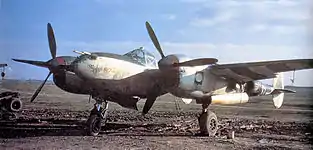IX Fighter Command
The IX Fighter Command was a United States Army Air Forces formation. Its last assignment was with the Ninth Air Force, based at Erlangen, Germany. It was inactivated on 16 November 1945.
| IX Fighter Command | |
|---|---|
 World War II Emblem of Ninth Air Force | |
| Active | 1942–1945 |
| Country | United States |
| Branch | United States Army Air Forces |
| Role | Fighter Command and Control |

IX Fighter Command was the primary tactical fighter air arm of Ninth Air Force in the Western Desert Campaign in North Africa during 1942-1943. Reassigned to England, it became the dominant tactical air force over the skies of Western Europe during the 1944 Battle of Normandy and the Western Allied invasion of Germany in 1945.
After its inactivation, the majority of its (along with Twelfth Air Force) units were incorporated into the postwar United States Air Force Tactical Air Command.
History
North Africa
In Egypt during January 1943, IX Fighter Command became the control organization for Ninth Air Force fighter units assigned to the Western Desert Campaign (Libya and Tunisia).
Although wings were officially subordinate to the command, combat groups were attached to the Desert Air Force, which included squadrons of the Royal Air Force, Royal Australian Air Force and South African Air Force.
IX Fighter Command was reassigned to England in November 1943 as part of Normandy invasion planning. Its subordinate units were reassigned to the Twelfth Air Force.
Western Europe
During the winter of 1943/44 IX Fighter Command expanded at an extraordinary rate so that by the end of May 1944, its complement ran to 45 flying groups operating some 5,000 aircraft. Initial missions from England consisted of fighter sweeps over troop concentrations and attacks on enemy positions and airfields, primarily on German Fifteenth Army units in the Pas-de-Calais region of France as well as around Normandy and Cotentin Peninsula. On D-Day IX Fighter Command units carried out massive air attacks on German forces in Normandy area with P-51 Mustang and P-47 Thunderbolt fighter-bombers. Air cover during the morning amphibious assault by Allied forces on the beaches of France was flown by P-38 Lightnings.
With the beaches secure, groups began deploying to France on June 16, 1944, ten days after the Normandy invasion by moving P-47 Thunderbolts to a beach-head landing strip. During the Battle of Normandy, its tactical air units then provided the air power for the Allied break-out from the Normandy beachhead in the summer of 1944 during the Battle of Cherbourg, Caen, and the ultimate breakout from the beachhead, Operation Cobra.
By early August most IX Fighter Command groups were transferred to bases in France and assigned to the U. S. Twelfth Army Group. Command then reorganized, with units transferred to three Tactical Air Commands and which directly supported Army ground units, along with an air defense command to defend Allied-controlled areas.
- XXIX Tactical Air Command supported the Ninth United States Army in the north
- IX Tactical Air Command supported the United States First Army in the center
- XIX Tactical Air Command supported the United States Third Army in the south
- IX Air Defense Command provided air defense of Allied-controlled Western Europe
After units reassigned, remained as command organization until after VE-Day when performed occupation duty in Germany.
Lineage
- Constituted as IX Interceptor Command on 19 January 1942
- Activated on 1 February 1942
- Redesignated IX Fighter Command in May 1942
- Inactivated on 16 November 1945
- Disbanded on 8 October 1948
Assignments
- Third Air Force, 1 February 1942
- Ninth Air Force, 31 January 1943 – 16 November 1945
North Africa
|
|
Western Europe


Wings
- 70th Fighter Wing: 29 November 1943 – 3 October 1944
- 71st Fighter Wing: 4 December 1943 – 1 July 1944
- 84th Fighter Wing: 30 April 1944 – 12 August 1944
- 100th Fighter Wing: 30 April 1944 – 1 November 1944
- 303d Fighter Wing: 8 March–1 November 1944
Groups
- 358th Fighter Group: 20 October 1943 – 1 August 1944
- Attached to VIII Fighter Command entire period
- 366th Fighter Group: 28 January–28 June 1945
- Attached to XXIX Tactical Air Command, 28 January–21 June 1945
- 368th Fighter Group: 13 January–1 August 1944
- 370th Fighter Group: 12 February–1 August 1944
- 371st Fighter Group: 4 April–1 August 1944
- 404th Fighter Group: 4 April–1 August 1944
- 405th Fighter Group: 7 March–1 August 1944
- 406th Fighter Group: 4 April–1 August 1944
- 474th Fighter Group: 12 March–1 August 1944
Squadrons
- 422d Night Fighter Squadron: 7–12 March 1944
- 425th Night Fighter Squadron: 23 May–10 June 1944
Stations
|
|
* Grass airstrip used for liaison and courier aircraft only
See also
References
 This article incorporates public domain material from the Air Force Historical Research Agency website http://www.afhra.af.mil/.
This article incorporates public domain material from the Air Force Historical Research Agency website http://www.afhra.af.mil/.- Maurer, Maurer (1983). Air Force Combat Units of World War II. Maxwell AFB, Alabama: Office of Air Force History. ISBN 0-89201-092-4.
- Johnson, David C. (1988), U.S. Army Air Forces Continental Airfields (ETO), D-Day to V-E Day; Research Division, USAF Historical Research Center, Maxwell AFB, Alabama.
.svg.png.webp)